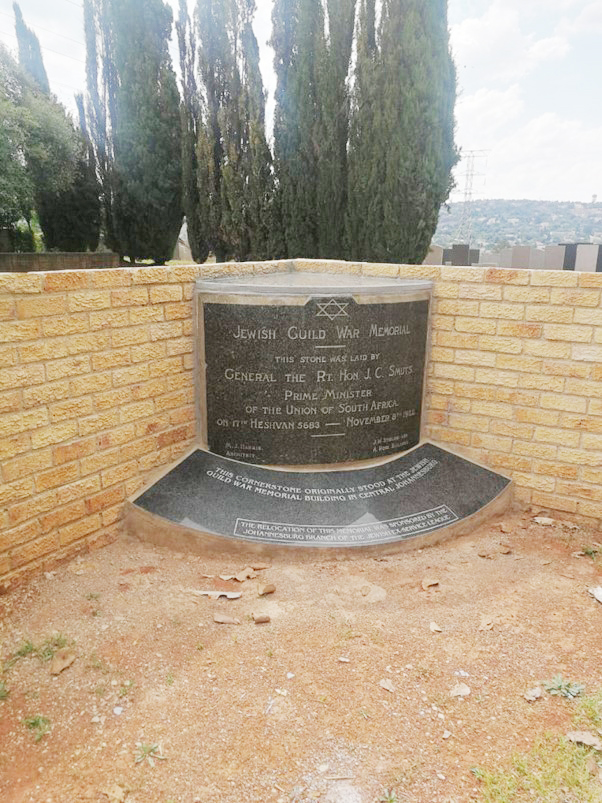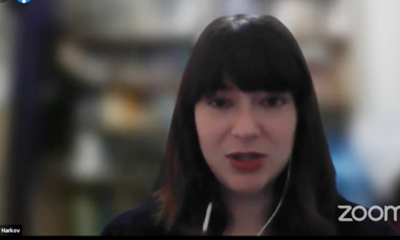
Community

Jan Smuts a cornerstone of Israel’s establishment, memorial finds
Published
1 year agoon
Gareth Shackleford, the great-grandson of the late Jan Smuts, unveiled the Jewish Guild War Memorial Building Cornerstone at Westpark Cemetery on 27 November, one century after his great-grandfather unveiled it at the Jewish Guild War Memorial Building in Johannesburg on 8 November 1922.
When the latter building was sold in 1957, the Jewish Guild and the cornerstone found a new home on Rivonia Road, Morningside, Johannesburg.
After the Jewish Guild property in Morningside was sold in the 1990s, the Guild and the cornerstone were relocated to the bowling club at the top of Sylvia Pass in Observatory, Johannesburg. The club subsequently closed down, but the stone remained there for many years until it was “rediscovered” by a member of the community in September 2022.
During November of the same year, the cornerstone was moved to the grounds of the South African National Jewish War Memorial at Westpark Jewish Cemetery, where people of all faiths and races, some wearing medals of battles past, came to watch the unveiling last Sunday.
They were there to remember the South African soldiers who sacrificed their lives in the two World Wars of the twentieth century. The acts of bravery by these soldiers contributed to the restoration of Jewish sovereignty in our ancestral homeland in 1948.
The ceremony honoured the memory of Smuts, whose less well-known history, notably his contribution to the state of Israel, is slowly being uncovered thanks to the efforts of the South African Zionist Federation (SAZF), the Jewish National Fund of South Africa, and the South African Jewish Ex-Service League, particularly its committee member, Selwyn Rogoff, and former chairperson, Peter Bailey.
“The Jewish Guild War Memorial has been dedicated to the memory of the South African Jewish soldiers who fell during the Great War, later known as World War I,” Shackleford said at the ceremony. “General Smuts, or the oubaas [old boss] as we all know him in the family, not only unveiled the cornerstone, he was also an active participant in the fundraising programme for the building.”
Shackleford said the Smuts family is forever bound to Israel through Kibbutz Ramat Yohanan, named in honour of the oubaas – “Yohanan” being the Hebrew translation of “Jan”. “Our grandmother, Louise, the youngest daughter of the oubaas, and Ouma Smuts and her husband, my grandfather, were hosted by the kibbutz on a visit to Israel in 1975. This was significant in cementing the relationship between the kibbutz and the Smuts family.”
Smuts and Dr Chaim Weizmann, the Zionist leader and Israel’s first president, met in London during the Great War. This sparked a close, life-long friendship which greatly influenced events in Palestine.
Research reveals that Smuts played a monumental backroom role in the drafting of the Balfour Declaration, providing Weizmann with a direct conduit to the war cabinet.
Hilton Kaplan, the national chairperson of the Ex-Service League, said at the ceremony, “We pay homage to General Jan Christian Smuts, the architect of the Union of South Africa, established in 1910, the self-governing dominion of the United Kingdom. General Smuts was acknowledged as a true friend of Zion at the Friends of Zion Museum in Jerusalem.”
Kaplan reiterated that Smuts played an integral part in the creation of the Balfour Declaration, although he had done so anonymously. “He was then involved in the diplomatic recognition of the state of Israel in 1948. Weizmann said, ‘Without Smuts, there would have been no Balfour Declaration, and hence no Israel.’”
The connections between the Jewish people, Israel, and the oubaas are numerous and cover many years, Shackleford said. “In June 1917, the oubaas met Weizmann, at the time professor of chemistry at the University of Manchester. The two would become life-long friends. They enjoyed one another’s company and were intellectually compatible. They shared the vision of a home for the Jews.
“It was worthy to note that the oubaas was a staunch Christian Zionist. Having been raised in conservative Calvinism, he held a strong belief in the historical connection and the right of the Jewish people to their own homeland. He maintained that Palestine, being the biblical home of the Jews, was where such a home should be. Weizmann naturally shared this vision, and found a staunch ally in General Smuts.
“Smuts, in his position as a member of the Imperial War Cabinet, had his advice sought and respected ahead of most and was thus in a unique position to add his voice to the cabinet deliberations. This influence extended to the national home for the Jewish people prior to the insurance of the Balfour Declaration.
“In January 1917, the SAZF asked Nathan Levi, a Zionist known to be a friend of Smuts, to use any personal influence and opportunities to obtain Smuts’s support for the SAZF resolution, which called for the peace conference after the end of the Great War to ensure the establishment of a homeland for the Jewish people in Palestine.
“In a speech delivered by Smuts at the banquet honouring him two years after the publication of the Balfour Declaration, he said, ‘When the resolutions passed by the Zionist Federation were brought to me, I gave my assurance that whenever I would have the choice, I would help Zionism. At the beginning of the movement in favour of the declaration of Palestine being the future home for the Jewish race, Weizmann approached me and pressed me very strongly. I told him of the promise I made on my sick bed in Irene. I did my best to carry it out.’
“In 1949, the oubaas was to see Weizmann, his friend of 32 years, for one last time, when, against all advice due to ill health, he travelled to London to make the speech at the dinner celebrating Weizmann’s 75th birthday. Two months later, the oubaas passed away.”
During a speech Smuts delivered in London in aid of German Jewish women and children after World War II, he said, “To me, this is the most important movement. This opening up of Palestine once more to the Jews. It’s one of the bright spots of the new world. I can see a vision of a new Palestine, a stream of tens of thousands of Jews going back home to their ancient homeland.”
Benji Shulman of the SAZF, which hosted the rededication ceremony said, “It was a unique opportunity to reconsider the many ways in which South Africa and Israel are connected, and perhaps even reconsider how we build on that connection to support just and sustainable solutions to the current problems in the Middle East.”









David Freund
Jan 29, 2023 at 8:01 am
It has been written that Jan Smuts was a major figure of his time, in so many ways. This would have been even greater had he been the leader of a major power and not a comparatively minor country in the global scheme of things. He was one of the great figures who influenced the path of history for the better of human kind, given the choices open to him during his life. A man of great gifts and talents who left his mark in the name of peace and hope for a better future.
I was born in Pretoria and grew up in Cape Town. Jan Smuts was a central figure for me, including his philosophy of Holism.
This I feel was ultimately at the heart of his life’s endeavour, for peace and prosperity for all humanity, as a unity of purpose.